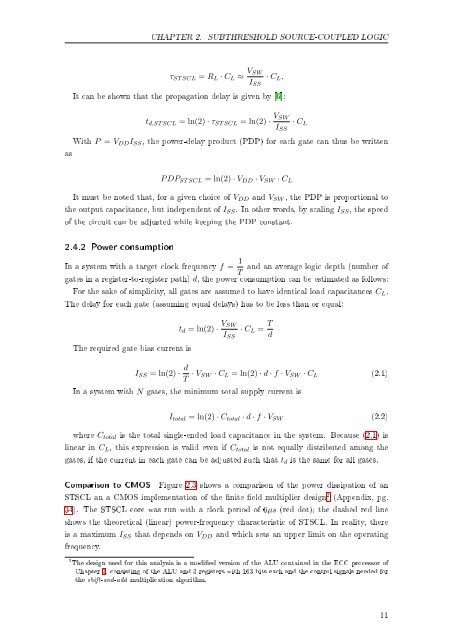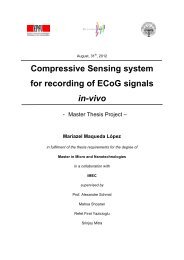Ultra-Low-Power Digital Circuit Design - Microelectronic Systems ...
Ultra-Low-Power Digital Circuit Design - Microelectronic Systems ...
Ultra-Low-Power Digital Circuit Design - Microelectronic Systems ...
- No tags were found...
Create successful ePaper yourself
Turn your PDF publications into a flip-book with our unique Google optimized e-Paper software.
CHAPTER 2.SUBTHRESHOLD SOURCE-COUPLED LOGICasτ ST SCL = R L · C L ≈ V SWI SS· C L ,It can be shown that the propagation delay is given by [6]:t d,ST SCL = ln(2) · τ ST SCL = ln(2) · VSWI SSWith P = V DD I SS , the power-delay product (PDP) for each gate can thus be written· C LP DP ST SCL = ln(2) · V DD · V SW · C LIt must be noted that, for a given choice of V DD and V SW , the PDP is proportional tothe output capacitance, but independent of I SS . In other words, by scaling I SS , the speedof the circuit can be adjusted while keeping the PDP constant.2.4.2 <strong>Power</strong> consumptionIn a system with a target clock frequency f = 1 and an average logic depth (number ofTgates in a register-to-register path) d, the power consumption can be estimated as follows:For the sake of simplicity, all gates are assumed to have identical load capacitances C L .The delay for each gate (assuming equal delays) has to be less than or equal:The required gate bias current ist d = ln(2) · VSWI SS· C L = T dI SS = ln(2) · dT · V SW · C L = ln(2) · d · f · V SW · C L (2.1)In a system with N gates, the minimum total supply current isI total = ln(2) · C total · d · f · V SW (2.2)where C total is the total single-ended load capacitance in the system. Because (2.1) islinear in C L , this expression is valid even if C total is not equally distributed among thegates, if the current in each gate can be adjusted such that t d is the same for all gates.Comparison to CMOSFigure 2.3 shows a comparison of the power dissipation of anSTSCL an a CMOS implementation of the nite eld multiplier design 2 (Appendix, pg.34). The STSCL core was run with a clock period of 6µs (red dot); the dashed red lineshows the theoretical (linear) power-frequency characteristic of STSCL. In reality, thereis a maximum I SS that depends on V DD and which sets an upper limit on the operatingfrequency.2 The design used for this analysis is a modied version of the ALU contained in the ECC processor ofChapter 3, consisting of the ALU and 3 registers with 163 bits each and the control signals needed forthe shift-and-add multiplication algorithm.11















